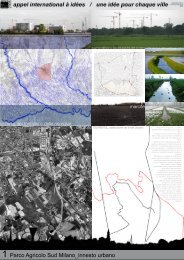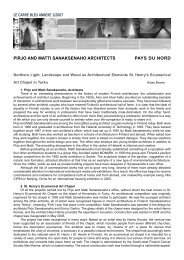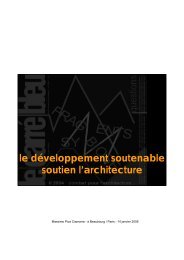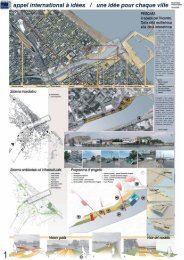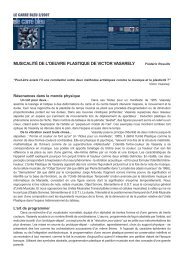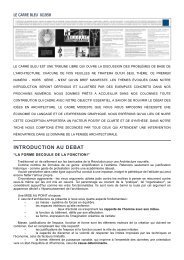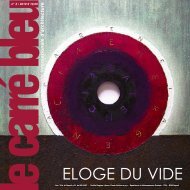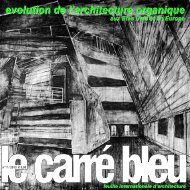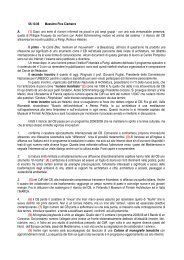ml 3 - Le Carré Bleu
ml 3 - Le Carré Bleu
ml 3 - Le Carré Bleu
Create successful ePaper yourself
Turn your PDF publications into a flip-book with our unique Google optimized e-Paper software.
Depuis l'abominable première guerre mondiale, on a<br />
élaboré une doctrine immobilière immobilisante et<br />
enrégimentante qui fut réalisée, urbi et orbi, depuis la<br />
deuxième. Une théorie qui pue le militarisme et qui<br />
convenait sans distinction à tous les totalitarismes et à<br />
toutes les bureaucraties qui tiennent la population à la<br />
gorge en entretenant partout une pénurie d'espaces. A une<br />
époque qui regorge de produits et de forces de travail<br />
inemployés. Il n'est pas étonnant que, face à l'homme privé<br />
d'espace et aussi d'initiatives, théorie et pratiques, tout<br />
explose, et en premier lieu les barres.<br />
Après le désastre, au moment où il s'apprêtait à se suicider,<br />
son fidèle valet demanda au Fuhrer : "Pour qui devonsnous<br />
désormais nous battre ?" "Pour l'homme nouveau ..."<br />
répondit-il et ce furent ses derniers mots. Depuis les<br />
modernes, on ne cesse de nous bassiner avec les nouveautés<br />
: nouvelle société, nouvelle politique, ville nouvelle<br />
et même programme d'architecture nouvelle ... puis on<br />
continue comme avant de construire les mêmes barres,<br />
avec les mêmes techniques et au nom des principes depuis<br />
longtemps acculés à l'acuité d'un coup de pied.<br />
4<br />
<strong>Le</strong> sommeil de la raison engendre des monstres. Après<br />
l'innocuité de l'incantation sur le "nouveau" pour changer<br />
quoi que ce soit, suivie par le lancement des nouveaux<br />
personnages qui remplacent désormais dans la presse, en<br />
guise de référentiel, toute référence rationnelle, tout repère,<br />
voici enfin le retour du vieux et hasardeux chaos. Une<br />
théorie sans risque où l'on n'apprend rien de concret,<br />
même pas une réponse simplifiante à cette question<br />
pourtant depuis longtemps posée : si ce n'est pas la barre -<br />
horizontale ou verticale, mince ou épaisse, droite ou<br />
courbe, peu importe - alors, qu'est-ce qu'on fait ? En<br />
somme, et voici le sujet du présent CB : quelle est la forme<br />
qui est le contraire de la barre ?<br />
C'est évidemment le tore : un corps qui entoure un trou, tel<br />
qu'il est représenté si sensiblement par Courbet. Et aussi,<br />
par extrapolation, les formes du tore multiple : empilements<br />
non-compacts, polyèdres infinis, espaces-éponges et<br />
autres milieux labyrinthiques, si semblables à notre<br />
environnement urbain complexe et naturel d'antan et dont<br />
l'architecture actuelle a oublié les secrets.<br />
himself the objective of squeezing as many housing "cells"<br />
as possible into a slablike block where both one's social<br />
and individual life are going to suffer irremediably without<br />
any reason for that either. He traces axes and périphéries,<br />
making mincemeat of the city, imprisoning it and<br />
destroying its urban fabric, while preventing its<br />
development. This is done so successfully that the city is<br />
trapped like a rat inside ring roads that have become<br />
barriers more powerful than even the strongest ramparts.<br />
Thus, with no way of extending the city, ail we get are<br />
suburbs, together with their problems.<br />
And yet an architect's task is to give a "rational" form to<br />
everything as Viollet-le-Duc prescribed. Any arbitrary or<br />
stupid décision, once it has been cast in concrète, makes<br />
a place uninhabitable and turns a town into a paralytic.<br />
That's the kind ofpower an architect has. It is immense, as<br />
great as his responsibility.<br />
Since the atrocity of the First World War, a housing theory<br />
has developed, an immobilizing and disciplinarian<br />
doctrine, put into practice after the Second World War, urbi<br />
et orbi. A theory that smacks of militarism and suits ail<br />
totalitarisms and bureaucraties alike, which are strangling<br />
people everywhere through a shortage of space. And this<br />
is happening in a period when products and unemployed<br />
labour abound. It is not a surprise that, in the face of man,<br />
spatially-deprived and lacking initiatives, both theory and<br />
practice, everything exploses and, first and foremost, the<br />
slabs themselves.<br />
Circonvolutions du<br />
cerveau humain<br />
After the disaster, when the Fuhrer was getting ready to<br />
commit suicide, his faithful valet asked him : "Who should<br />
we fight for now ?" - "For the new man ...*, he answered and<br />
those were his last words. Since the modems, we have<br />
been forever plagued by novelties : new society, new<br />
politics, new towns and even a new architecture program<br />
... but we keep on building the same slabs as before, using<br />
the same techniques and in the name of principles that<br />
have long since been pitched astern by a good, keen kick.<br />
The slumber of reason will bring forth monsters. After<br />
inoculation of the incantation on "novelty", unable to<br />
change anything, followed by the launching of new<br />
personalities who now, by way of référence, replace any<br />
rational referenciation of bearings in the média, here, at<br />
last, our old, chancy chaos is back. A safe theory whereby<br />
nothing concrète can be learned, not even a simplifying<br />
answer to a question that has been awaiting an answer for<br />
a long time : if we don't want blocks - whether they are<br />
horizontal or vertical, thick or thin, straight or curved - then,<br />
what do we want ? Briefly, this is the subject of the présent<br />
issue of <strong>Carré</strong> <strong>Bleu</strong> : what shape is the opposite of a slab ?<br />
It can only be a tore : a body enveloping a hole, as<br />
represented so finely by Courbet. And also, by extrapolation,<br />
multiple tore shapes : non-compact packing, infinité<br />
polyhedra, sponge-spaces and other labyrinthine areas, so<br />
akin to our old natural, complex urban environment, whose<br />
secrets present-day architecture has forgotten.



